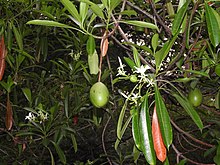Cerbera manghas (formerly Cerbera tanghin),[1] commonly known as the sea mango, tangena or bintaro is a small evergreen coastal tree growing up to 12 metres (39 ft) tall. It is native to coastal areas in Africa, Asia, Australasia, and the Pacific islands. It is classified as one of the three species in the genus Cerbera that constitute mangroves.
| Cerbera manghas | |
|---|---|

| |
| Scientific classification | |
| Kingdom: | Plantae |
| Clade: | Tracheophytes |
| Clade: | Angiosperms |
| Clade: | Eudicots |
| Clade: | Asterids |
| Order: | Gentianales |
| Family: | Apocynaceae |
| Genus: | Cerbera |
| Species: | C. manghas
|
| Binomial name | |
| Cerbera manghas | |
| Synonyms | |
|
Synonyms list
| |
Description edit
The shiny dark-green leaves grow in a spiral arrangement, and are ovoid in shape. The flowers are fragrant, possessing a white tubular five-lobed corolla about 3–5 cm (1.2–2.0 in) in diameter, with a pink to red throat. They have five stamens and the ovary is positioned above the other flower parts. The fruits are egg-shaped, 5–10 cm (2.0–3.9 in) long. At maturity they turn bright red.
Toxicity edit
The leaves and the fruits contain the extremely toxic cardiac glycoside cerberin, as well as tanghinin, deactyltanghin, and neriifolin. Only the mechanism of action for cerberin has been extensively studied, although tanghinin and the other molecules are likely proceed through a similar mechanism. Cerberin acts by affecting sodium-potassium pumps in cardiac muscle cells via inhibition of Na+/K+-ATPase.[2][3] In addition to its cardiac effects, symptoms of poisoning include numbness in the upper extremities followed by nausea, vomiting, chest tightness, and dyspnea.[4] Cerberin is believed to be the most important contributor to the toxicity of the plant, although it is found in lower quantities than the other cardiac glycosides.
More modern medical research indicates that the cerberin found in the plant might have favorable properties for chemotherapy as the cardiac glycoside might be able to selectively induce apoptosis in tumor cells.[5]
Like the closely related Cerbera odollam, Cerbera manghas seeds have been purposely ingested in suicide attempts.[4][6]
Goffin's cockatoo is one of the creatures known to eat sea mangos.[7] In addition, the Coconut crab can become toxic to humans if it eats too much sea mango due to a buildup of cardiac cardenolides.
Historical Uses edit
During the Merina Kingdom's rule of the island of Madagascar, Cerbera manghas was used in tangena trials by ordeal to test suspected criminals and witches.[8][9] Poison from nuts of the plant would be consumed in combination with three strips of chicken, and if the chicken was not vomited, then the person would be found guilty and executed.[10] The use of the plant peaked during the reign of Queen Ranavalona I, where it was estimated that over 100,000 people were killed.[11] The tangena ordeal was eventually banned during the reign of Radama II.
On the opposite spectrum, Fijians use its (vasa, rewa) leaves in dried form to treat skin irritations and eye pains.[12]
Long ago, people used the sap of the tree as a poison for animal hunting.[13]
Gallery edit
-
Colorized plate showing the halved fruits containing the toxic seeds
-
Flower
-
Unripe fruit
See also edit
- Cerbera odollam
- Calabar bean – A plant used for trials by ordeal in Old Calabar
- Digitalis – Genus of plants that are used as a source for cardiac glycosides in medicine
References edit
- ^ POWO: Cerbera manghas L.
- ^ Babula P, Masarik M, Adam V, Provaznik I, Kizek R (September 2013). "From Na+/K+-ATPase and cardiac glycosides to cytotoxicity and cancer treatment". Anti-Cancer Agents in Medicinal Chemistry. 13 (7): 1069–1087. doi:10.2174/18715206113139990304. PMID 23537048. S2CID 1537056.
- ^ "CV Pharmacology | Cardiac Glycosides (Digitalis Compounds)". cvpharmacology.com. Retrieved 2017-06-08.
- ^ a b Tsai, Yi-Cheng; Chen, Chun-Yu; Yang, Ning-I; Yang, Chen-Chang (2008). "Cardiac glycoside poisoning following suicidal ingestion of Cerbera manghas". Clinical Toxicology. 46 (4): 340–341. doi:10.1080/15563650701291766. ISSN 1556-3650.
- ^ Yadav, Neelam; Mishra, Yoganchal (2020-10-02), "Targeting the PI3K/AKT/mTOR Signaling Pathway in Hepatocellular Carcinoma: Current State and Future Trends", Advances in Cancer Signal Transduction and Therapy, BENTHAM SCIENCE PUBLISHERS, pp. 85–98, retrieved 2024-04-25
- ^ Misek, Ryan; Allen, Glenn; LeComte, Valerie; Mazur, Nicholas (2018). "Fatality Following Intentional Ingestion of Cerbera odollam Seeds". Clinical Practice and Cases in Emergency Medicine. 2 (3). doi:10.5811/cpcem.2018.5.38345.
- ^ Yirka, Bob (September 3, 2021). "Wild cockatoos observed making and using tools to eat sea mango pits". phys.org.
- ^ "33. Le Tanghin (Cerbera)". Catalogue des fruits et des plantes modelés (in French). Paris: Carporama. 1829. pp. 25–26.
- ^ Boiteau, Pierre (1999). "tangena". Dictionnaire des noms malgaches de végétaux (in French). Vol. III. Editions Alzieu – via Malagasy Dictionary and Malagasy Encyclopedia.
- ^ Robb, George L. (1957). "The Ordeal Poisons of Madagascar and Africa". Botanical Museum Leaflets, Harvard University. 17 (10): 265–316. ISSN 0006-8098.
- ^ Campbell, Gwyn (October 1991). "The state and pre-colonial demographic history: the case of nineteenth century Madagascar". Journal of African History. 23 (3): 415–445. doi:10.1017/S0021853700031534.
- ^ Keppel, Gunnar; Ghazanfar, Shahina A. (2011). Trees of Fiji: A Guide to 100 Rainforest Trees (third, revised ed.). Secretariat of the Pacific Community & Deutsche Gesellschaft für Technische Zusammenarbeit. pp. 44–5.
- ^ "Cerbera manghas L." Flora Fauna Web. Retrieved October 4, 2017.
- Media related to Cerbera manghas at Wikimedia Commons